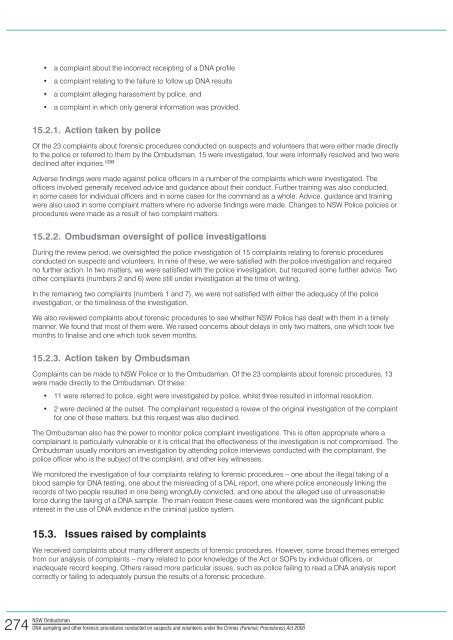Crimes (Forensic Procedures) Act 2000 - NSW Ombudsman - NSW ...
Crimes (Forensic Procedures) Act 2000 - NSW Ombudsman - NSW ...
Crimes (Forensic Procedures) Act 2000 - NSW Ombudsman - NSW ...
You also want an ePaper? Increase the reach of your titles
YUMPU automatically turns print PDFs into web optimized ePapers that Google loves.
• a complaint about the incorrect receipting of a DNA profile<br />
• a complaint relating to the failure to follow up DNA results<br />
• a complaint alleging harassment by police, and<br />
• a complaint in which only general information was provided.<br />
15.2.1. <strong>Act</strong>ion taken by police<br />
Of the 23 complaints about forensic procedures conducted on suspects and volunteers that were either made directly<br />
to the police or referred to them by the <strong>Ombudsman</strong>, 15 were investigated, four were informally resolved and two were<br />
declined after inquiries. 1293<br />
Adverse findings were made against police officers in a number of the complaints which were investigated. The<br />
officers involved generally received advice and guidance about their conduct. Further training was also conducted,<br />
in some cases for individual officers and in some cases for the command as a whole. Advice, guidance and training<br />
were also used in some complaint matters where no adverse findings were made. Changes to <strong>NSW</strong> Police policies or<br />
procedures were made as a result of two complaint matters.<br />
15.2.2. <strong>Ombudsman</strong> oversight of police investigations<br />
During the review period, we oversighted the police investigation of 15 complaints relating to forensic procedures<br />
conducted on suspects and volunteers. In nine of these, we were satisfied with the police investigation and required<br />
no further action. In two matters, we were satisfied with the police investigation, but required some further advice. Two<br />
other complaints (numbers 2 and 6) were still under investigation at the time of writing.<br />
In the remaining two complaints (numbers 1 and 7), we were not satisfied with either the adequacy of the police<br />
investigation, or the timeliness of the investigation.<br />
We also reviewed complaints about forensic procedures to see whether <strong>NSW</strong> Police has dealt with them in a timely<br />
manner. We found that most of them were. We raised concerns about delays in only two matters, one which took five<br />
months to finalise and one which took seven months.<br />
15.2.3. <strong>Act</strong>ion taken by <strong>Ombudsman</strong><br />
Complaints can be made to <strong>NSW</strong> Police or to the <strong>Ombudsman</strong>. Of the 23 complaints about forensic procedures, 13<br />
were made directly to the <strong>Ombudsman</strong>. Of these:<br />
• 11 were referred to police, eight were investigated by police, whilst three resulted in informal resolution.<br />
• 2 were declined at the outset. The complainant requested a review of the original investigation of the complaint<br />
for one of these matters, but this request was also declined.<br />
The <strong>Ombudsman</strong> also has the power to monitor police complaint investigations. This is often appropriate where a<br />
complainant is particularly vulnerable or it is critical that the effectiveness of the investigation is not compromised. The<br />
<strong>Ombudsman</strong> usually monitors an investigation by attending police interviews conducted with the complainant, the<br />
police officer who is the subject of the complaint, and other key witnesses.<br />
We monitored the investigation of four complaints relating to forensic procedures – one about the illegal taking of a<br />
blood sample for DNA testing, one about the misreading of a DAL report, one where police erroneously linking the<br />
records of two people resulted in one being wrongfully convicted, and one about the alleged use of unreasonable<br />
force during the taking of a DNA sample. The main reason these cases were monitored was the significant public<br />
interest in the use of DNA evidence in the criminal justice system.<br />
15.3. Issues raised by complaints<br />
We received complaints about many different aspects of forensic procedures. However, some broad themes emerged<br />
from our analysis of complaints – many related to poor knowledge of the <strong>Act</strong> or SOPs by individual officers, or<br />
inadequate record keeping. Others raised more particular issues, such as police failing to read a DNA analysis report<br />
correctly or failing to adequately pursue the results of a forensic procedure.<br />
274<br />
<strong>NSW</strong> <strong>Ombudsman</strong><br />
DNA sampling and other forensic procedures conducted on suspects and volunteers under the <strong>Crimes</strong> (<strong>Forensic</strong> <strong>Procedures</strong>) <strong>Act</strong> <strong>2000</strong>

















